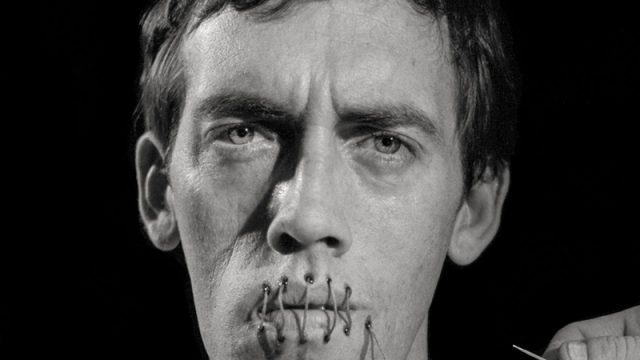
David Wojnarowicz tells his own story in Chris McKim documentary (Andreas Sterzing, David Wojnarowicz (Silence = Death), photograph, 1989 [courtesy of the artist, the estate of David Wojnarowicz, and P·P·O·W, New York])
WOJNAROWICZ: F**K YOU F*GGOT F**KER (Chris McKim, 2020)
Film Forum Virtual Cinema
Opens Friday, March 19; live Q&A on Tuesday, March 30, free with RSVP, 7:00
filmforum.org
kinomarquee.com
David Wojnarowicz packed a whole lot of living into his too-brief thirty-seven years, and the frenetic pace of his life and death is copiously captured in Chris McKim’s dynamic documentary, Wojnarowicz: F**k You F*ggot F**ker. Born in New Jersey in September 1954, Wojnarowicz — pronounced VOY-nah-ROH-vich — experienced a difficult childhood riddled with physical abuse from his father, became a teen street hustler in Times Square, and later dabbled in heroin. He gained fame as an avant-garde artist and anti-AIDS activist in the 1980s, when several of his pieces earned notoriety, condemned by right-wing politicians who wanted to censor the works and defund the National Endowment for the Arts, which had supported the shows of art they found objectionable or morally corrupt. (The controversy continued decades past his death, into December 2010, when the National Portrait Gallery edited his short film Fire in My Belly in a group show.)
McKim lets Wojnarowicz, who died of AIDS-related complications in July 1992, tell his own story, using the multimedia artist’s extensive archive of journals, cassette tapes, phone messages, photographs, and super 8 films; Wojnarowicz lived his life as if it was an ongoing radical performance installation itself, obsessively recording himself. “All the paintings are diaries that I always thought as proof of my own existence,” he says. “Whatever work I’ve done, it’s always been informed by what I experience as an American in this country, as a homosexual in this country, as a person who’s legislated into silence in this country.”
Editor Dave Stanke does a masterful job of putting it all together, primarily chronologically, seamlessly melding Wojnarowicz’s paintings, photographs, and videos into a compelling narrative that is as experimental, and successful, as the artist’s oeuvre, placing the audience firmly within its milieu. He intercuts news reports and other archival footage as Wojnarowicz’s life unfolds; among those whose voices we hear, either in new interviews or old recordings, are cultural critics Fran Lebowitz and Carlo McCormick, gallerist Gracie Mansion, curator Wendy Olsoff, his longtime partner Tom Rauffenbart, photographer and close friend/onetime lover Peter Hujar, artists Kiki Smith and Nan Goldin, artist and activist Sur Rodney Sur, Fire in the Belly author Cynthia Carr, Wojnarowicz’s siblings, and photographer and filmmaker Marion Scemama, who collaborated with Wojnarowicz on the haunting Untitled (Face in Dirt), pictures of the artist partially buried in the southwest desert. In addition, McKim includes such conservative mouthpieces as Donald Wildmon of the American Family Association and Senator Jesse Helms, who both sought to shut down Wojnarowicz and the NEA.
Influenced by such writers and artists as Jean Genet, William S. Burroughs, and Arthur Rimbaud, Wojnarowicz’s art is as bold and in your face as it can get, relentlessly depicting a hypocritical world inundated with lies, violence, and perpetual inequality. Among the works that are examined in the film are Untitled (Buffalo), Untitled (Peter Hujar), Gagging Cow at Pier, Arthur Rimbaud in New York (Times Square), Burning House, Untitled (One Day This Kid . . . , David Wojnarowicz (Silence = Death, New York), Untitled (Genet After Brassai), and his Fire, Water, Earth, and Air four elements series. McKim also focuses on Wojnarowicz’s incendiary East Village punk band, 3 Teens Kill 4, with snippets of such songs as “Hold Up,” “Hunger,” and “Stay & Fight.” Wojnarowicz spoke in a relatively calm, straightforward tone, especially when compared with the constant whirlwind surrounding him, but his work, from art to music, revealed the fiery emotions bubbling inside, a roiling mix of rage, rebellion, and resistance.

Self-Portrait of David Wojnarowicz, acrylic and collaged paper on gelatin silver print, 1983–84 (photo by Ron Amstutz/Whitney Museum of American Art)
McKim (RuPaul’s Drag Race, Out of Iraq) adds a curious, overly sentimental modern-day ending that might elicit a tear or two but is completely out of place; otherwise, Wojnarowicz: F**k You F*ggot F**ker, named after one of the artist’s works from 1984, is an intense journey into the mind of a deeply troubled soul who shared his endless dilemmas in very public ways that made so many people uneasy. “Last night I was standing around here, looking at my photographs. They’re my life, and I don’t owe it to anybody to distort that just for their comfort,” he says.
Wojnarowicz: F**k You F*ggot F**ker opens virtually at Film Forum through Kino Marquee on March 19 and includes a prerecorded Q&A with McKim, Mansion, McCormick, and producer Fenton Bailey, moderated by journalist Jerry Portwood. There will also be a live Q&A on March 30 at 7:00 with McKim and Stanke, moderated by artist and activist Leo Herrera, that is free and open to all.